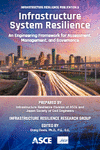Back Matter for Infrastructure System Resilience
Publication: Infrastructure System Resilience: An Engineering Framework for Assessment, Management, and Governance
Abstract
Back matter pages come after the papers or chapters in a published work. This back matter contains an index.
Formats available
You can view the full content in the following formats:
Information & Authors
Information
Published In
Infrastructure System Resilience: An Engineering Framework for Assessment, Management, and Governance
Pages: 75 - 76
Editor: Craig Davis, Ph.D., P.E., G.E.
ISBN (Online): 978-0-7844-8508-8
Copyright
© 2023 American Society of Civil Engineers.
History
Published online: Sep 25, 2023
Authors
Metrics & Citations
Metrics
Citations
Download citation
If you have the appropriate software installed, you can download article citation data to the citation manager of your choice. Simply select your manager software from the list below and click Download.
